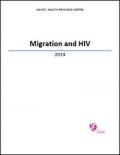Publications - Released in 2014
Being a migrant is not a risk factor in itself, but poorer health and higher HIV vulnerability among migrants are explained by: discrimination, gender inequality, sexual violence and exploitation, dangerous working environments, poor living conditions, poor access to education and social services and, most importantly, poor access to health care. Migrants often lack access to mainstream health care, education and social services. Many migrants do not have legal status within their destination countries and live in isolation, making it difficult to protect themselves against the people who might exploit them or sexually abuse them. Social isolation and other factors may lead migrants to participate in high-risk behavior, including use of drugs and alcohol.
This regional review is curtailed due to the breadth of the topic. Migratory trends, economic push-pull factors, HIV epidemiological data, legal and policy environments, as well as national/regional HIV programming are all essential elements of any discussion on HIV and migration. This review will touch on all of these elements in a limited fashion while focusing on two high-volume migratory corridors that reflect the current trends in HIV epidemiology among migrant and mobile populations in Asia and the Pacific.
Downloads
Organizations
- Swasti






